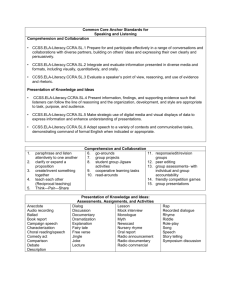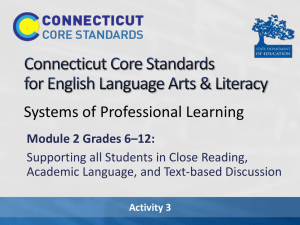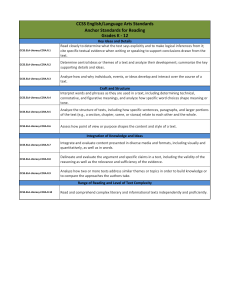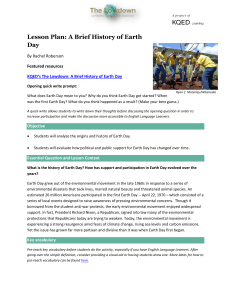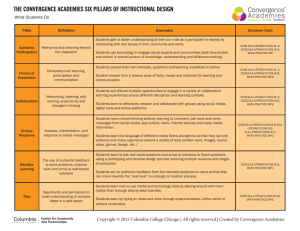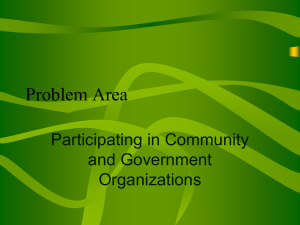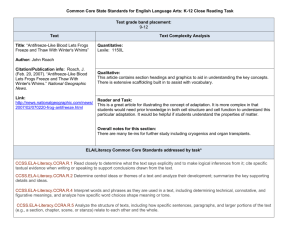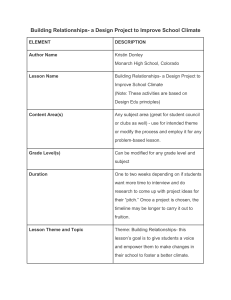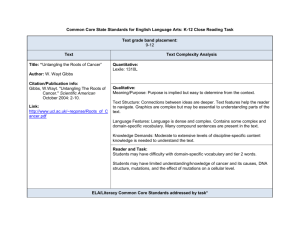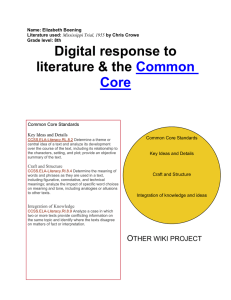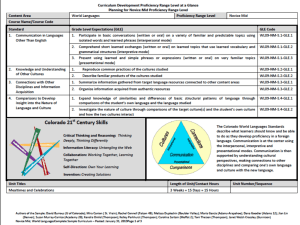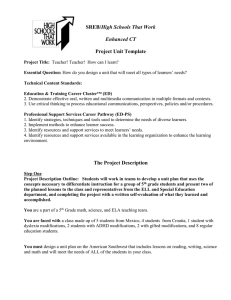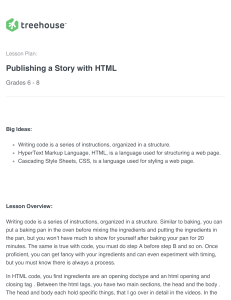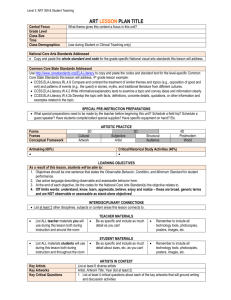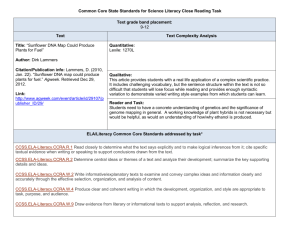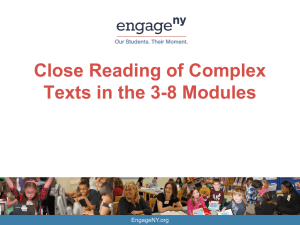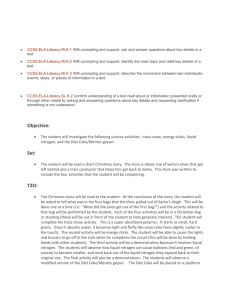Presentation - Connecticut Core Standards
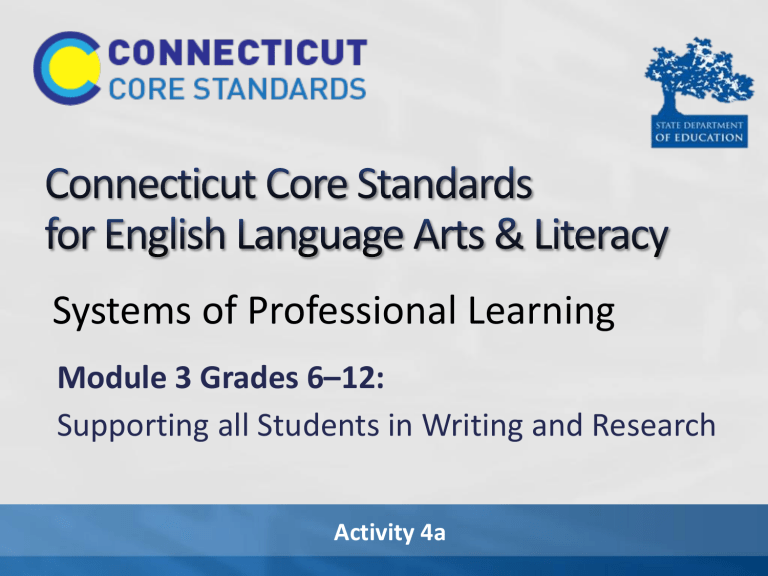
Systems of Professional Learning
Module 3 Grades 6–12:
Supporting all Students in Writing and Research
Activity 4a
CCS Writing and Research
Successes and Challenges
Close Look at the Writing Standards
Creating Claims and Writing
Grounded in Evidence from Text
Inquiry and Research in CCS ELA &
Literacy
Routine and Daily Writing
Supporting Students in Writing
Activity 4a
27
Creating Claims and Writing Grounded in
Evidence from Text
Page 21
28
Textdependent answers
Writing from sources
Reading, writing, and speaking grounded in evidence from text
Activity 4a
29
CCSS.ELA-Literacy.CCRA.W.1
Write arguments to support claims in an analysis of substantive topics or texts …
CCSS.ELA-Literacy.CCRA.W.2
Write informative/explanatory texts to examine and convey
…information… analysis of content
CCSS.ELA-Literacy.CCRA.W.7
Conduct short as well as more sustained research…
CCSS.ELA-Literacy.CCRA.W.8
Gather …information from … print and digital sources…
CCSS.ELA-Literacy.CCRA.W.9
Draw evidence from literary or informational texts to support analysis, reflection, and research .
Activity 4a
30
Grade 6‒12 Summative Assessment Targets, Claim #2
Students can produce effective writing for a range of purposes and audiences, including evidence from composing, revising, and/or editing.
20% narrative.
40% explanatory/informational, based on evidence from given sources.
40% opinion/argument, based on evidence from given sources.
Activity 4a
31
Robots Narrative Performance Task
You have joined a creative writing club. The assignment is to write a science fiction story for the group on a topic you research.
You must include information from research that you have done.
You have decided to research the topic of robots. Below are four sources you have uncovered in your research (two essays, an article, and an image)…
Write a multi-paragraph story about a robot that all of a sudden comes alive. Tell the story of what happens. Make sure you develop your characters, setting, and plot using details, dialogue, and description where appropriate. When developing your story, use the source materials to inform and strengthen your writing.
Activity 4a
32
Provide three arguments from the sources that support the position that the penny should be preserved.
that support the position that the penny should be eliminated.
Include the title or the number of the source for each argument you provide.
#1 Article from National Review “Should We Make Cents?”
#2 Article coin collectors' website. “The Many Faces of the Penny.”
#3 Letter to the editor - the Prairie News Register, December 26,
2012 “The Cost of a Penny.”
#4 Article middle school student newspaper. “Save the Penny—
Save the Day!”
Activity 4a
33
Your city council is holding a meeting to decide if city funds should be used to finance public art in your town. Read the 4 sources.
Source #2 makes some general claims about public art. One of these claims states:
“Through government partnerships, public art can also transform dull or run-down public spaces and inspire the people who live and work there.”
Identify another source that addresses this claim and explain two ways in which that source supports the claim.
According to these sources, what are some potential challenges artists might face when creating public art pieces that are government-funded? Provide three challenges from at least two sources.
Activity 4a
34
"Findings from this study suggest that teachers needn't teach to the test in a narrow, evaluationfocused manner; rather, they can develop tools that move students toward test-readiness while keeping writing process principles in focus.“
Julie Wollman-Bonilla (2004)
Activity 4a
35
1. Examine successful methods that exceptional teachers of literacy commonly apply when teaching writing
2. Draw from scientific studies testing the effectiveness of specific writing practices
Activity 4a
36
Talk at your table and determine 3 or more practices all agree would be considered “best practices” in teaching writing.
Activity 4a
37
A supportive and collaborative environment where writing can flourish
Use of writing strategies
Proficient foundational writing skills
Activity 4a
38
Activity 4a: Writing About Text
1. Your table group will be assigned one section of “Best Practices in
Writing about Text.”
2. Read individually and use sticky notes to highlight/annotate key ideas. Please do not write on the handout.
3. Summarize together and decide how to share the information with others.
4. Regroup so that each table has at least one member who has read each section.
Page 21
5. In turn, “teach” your section of the chapter.
6. Discuss the types of supports students and teachers will need.
Activity 4a
39
Your table will be assigned to read the one section of the chapter “Best Practices in Writing about Text.”
Sections are as follows:
1. Intro ‒ pp. 334–335
2. Writing to Text Models – pp. 336–338
3. Summarizing Text – pp. 338–340
4. Writing about Text – bottom p. 340–p. 343
5. Text Synthesis – pp. 343–347
Do not write on the hard copy of article. Please return copies when this activity is completed.
Shanahan, T. (2013). Best practices in Writing About Text, in S. Graham, C. A. MacArthur, & J. Fitzgerald (Eds.),
Best Practices in Writing Instruction (2nd ed., ch. 14, pp. 334-350 ), New York, NY: Guilford Press. http://www.guilford.com/books/Best-Practices-in-Writing-Instruction/Graham-MacArthur-Fitzgerald/9781462510085/contents
Activity 4a
40
